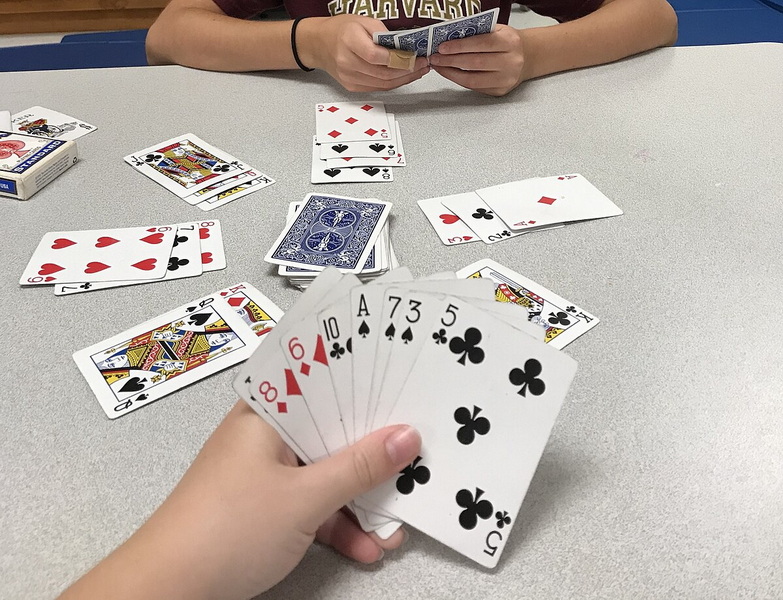Content Menu
● Introduction
● Overview of Spades
● Setup for Two Players
>> Preparing the Deck
>> Drawing Cards
>> Bidding Phase
● Gameplay Mechanics
>> Leading and Following Suit
>> Breaking Spades
>> Winning Tricks
>> Strategy During Play
● Scoring System
>> Handling Bags
>> Winning the Game
● Strategies for Winning at Two-Player Spades
● Common Mistakes to Avoid
● Variations of Two-Player Spades
● Conclusion
● Related Questions
>> 1. Can Spades be played with more than two players?
>> 2. What happens if both players reach 500 points?
>> 3. How do I score Nil bids?
>> 4. What are bags in Spades?
>> 5. Can I lead with spades at any time?
● Citations:
Introduction
Spades is a popular trick-taking card game traditionally played by four players divided into two teams. However, it can also be played with just two players, offering an engaging and competitive experience. This article will provide a comprehensive guide on how to play Spades with two players, covering the rules, strategies, and scoring systems. By the end of this article, you will be well-equipped to enjoy this classic card game with a friend.

Overview of Spades
Spades is played with a standard 52-card deck where the objective is to accurately predict the number of tricks you can win in each round. The game is known for its strategic depth and social interaction, making it a favorite among card enthusiasts. The key features of Spades include:
- Players: 2 (for this variant) or 4 in traditional play.
- Deck: Standard 52-card deck.
- Objective: Reach 500 points by winning tricks based on your bids.
Setup for Two Players
Preparing the Deck
To start, shuffle a standard 52-card deck thoroughly. Unlike traditional Spades where cards are dealt, in the two-player version, players will draw cards from the deck.
Drawing Cards
Each player takes turns drawing cards from the deck. The process is as follows:
- Player A draws the top card and decides whether to keep it or discard it.
- If Player A keeps the first card, they must discard the second card drawn.
- Player B then follows the same process.
- This continues until each player has drawn 13 cards, resulting in a complete hand of 26 cards being used while 26 remain unused.
Bidding Phase
Once both players have their hands, they enter the bidding phase:
- Players must declare how many tricks they believe they can win based on their hands.
- The player who did not draw first (Player B) bids first.
- Bids can range from 0 (Nil) to 13 tricks.
Nil Bids: A player may bid Nil if they believe they will not win any tricks. Successfully achieving a Nil bid earns them a bonus of 100 points, while failing incurs a penalty of -100 points.
Blind Nil Bids: Before looking at their cards, a player can bid Blind Nil (or Double Nil), allowing them to exchange up to three cards with those discarded earlier. If successful, they earn 200 points; if not, they lose 200 points.
Gameplay Mechanics
Leading and Following Suit
The player who bids second (Player B) leads the first trick by playing any card except for spades. The rules for following suit are as follows:
- Players must follow the suit led if possible.
- If unable to follow suit, players may play any card; playing a spade will trump any other suit unless another spade is played.
Breaking Spades
Spades cannot be led until they have been "broken." This occurs when a player plays a spade because they cannot follow suit or leads with spades after another suit has been played. Once spades are broken, they can be led in subsequent tricks.
Winning Tricks
The trick is won by the player who plays the highest card of the leading suit or the highest spade if one is played. The winner collects the cards and leads the next trick.
Strategy During Play
During gameplay, strategic decisions are crucial:
- Card Counting: Keep track of which cards have been played to gauge what your opponent might have left in their hand.
- Timing Your Plays: Decide when to play high cards versus lower ones based on your assessment of your opponent's potential plays.
- Bluffing and Deception: Sometimes it may be beneficial to play lower cards early on to mislead your opponent about your hand strength.

Scoring System
Scoring in Spades is straightforward but requires careful attention to detail:
- Each trick won counts as 10 points towards fulfilling your bid.
- If you meet your bid exactly, you score points equal to your bid multiplied by 10.
- For every trick won above your bid (overtricks), you receive an additional point each.
- Failing to meet your bid results in losing points equal to your bid multiplied by -10.
Handling Bags
Overtricks are referred to as "bags." If you accumulate ten bags throughout the game, you incur a penalty of -100 points. Therefore, managing your bids and avoiding excessive overtricks is crucial.
Winning the Game
The game continues until one player reaches 500 points or another predetermined score. In case both players reach or exceed this score in one hand, the player with the higher score wins.
Strategies for Winning at Two-Player Spades
Winning at Spades requires strategic thinking and careful planning:
1. Assess Your Hand: Evaluate your cards before bidding; consider high cards and potential suits you can dominate.
2. Bidding Wisely: Avoid underbidding; it's better to take calculated risks than to lose significant points for failing to meet your bid.
3. Manage Your Bags: Aim for minimal bags; keep track of how many tricks you have won above your bid and adjust your strategy accordingly.
4. Observe Your Opponent: Pay attention to your opponent's plays and adjust your strategy based on their bidding patterns and card choices.
5. Timing Your Nil Bid: Use Nil bids strategically when you have weak hands but ensure you can execute them successfully without winning any tricks.
6. Endgame Strategy: As you approach the endgame phase where scores are close, consider adjusting your strategy based on what you know about your opponent's hand and their previous bids.
Common Mistakes to Avoid
While playing Spades can be enjoyable, there are common pitfalls that players should avoid:
1. Overbidding: One of the most frequent mistakes is overestimating one's hand strength leading to failed bids and point losses.
2. Ignoring Bags: Failing to manage bags can lead to penalties that might swing the game unexpectedly against you.
3. Poor Card Management: Not keeping track of which cards have been played can lead to suboptimal decisions during play.
4. Neglecting Opponent's Strategy: Focusing solely on one's own hand without considering what cards might remain in an opponent's hand can lead to missed opportunities or unnecessary losses.
5. Rushing Decisions: Taking time during bidding and play phases allows for better strategic planning rather than making hasty choices that could cost points.
Variations of Two-Player Spades
While this article focuses on standard two-player Spades rules, there are various fun variations that players might enjoy:
1. Partnership Play with Two Teams: If you have four players available but want to maintain a two-player dynamic, consider forming partnerships where two players work together against another pair.
2. Speed Spades: Introduce time limits for bidding and playing each trick for a fast-paced version that keeps everyone engaged.
3. Scoring Variations: Experiment with different scoring systems such as awarding bonus points for winning all tricks in a round or implementing penalties for failing Nil bids that differ from traditional rules.
4. Wild Cards: Introduce wild cards that can represent any card in play—this adds an extra layer of strategy and unpredictability!
5. Multiple Rounds with Changing Roles: Play multiple rounds where roles switch between drawing first or leading tricks; this keeps gameplay fresh and exciting.
Conclusion
Playing Spades with two players offers an exciting twist on this classic game while maintaining its strategic depth and competitive spirit. By understanding the rules, setup, gameplay mechanics, scoring systems, strategies, common mistakes to avoid, and variations outlined in this guide, you can confidently engage in thrilling matches with friends or family members.
With practice and strategic thinking, you'll not only enjoy playing but also improve your skills over time. So gather your cards and get ready for some fun!

Related Questions
1. Can Spades be played with more than two players?
Yes, Spades is traditionally played with four players divided into two partnerships.
2. What happens if both players reach 500 points?
If both players reach or exceed 500 points in one hand, the player with the higher score wins; if tied, another hand is played.
3. How do I score Nil bids?
A successful Nil bid earns you +100 points; failing incurs -100 points.
4. What are bags in Spades?
Bags refer to overtricks won beyond your original bid; accumulating ten bags results in a -100 point penalty.
5. Can I lead with spades at any time?
You cannot lead with spades until they have been broken by playing one during a previous trick due to inability to follow suit or leading after another suit has been played.
Citations:
[1] https://vipspades.com/blog/how-to-play-spades-with-2-people/
[2] https://www.usatoday.com/story/graphics/2024/06/15/how-to-play-spades-card-game/72260535007/
[3] https://www.thesprucecrafts.com/complete-rules-of-spades-for-two-players-412489
[4] https://artofcards.in/blogs/post/master-the-classic-card-game-how-to-play-spades-with-2-or-4-players
[5] https://spades.co/how-to-play-spades
[6] https://spades.co/how-to-play-spades-2-people
[7] https://en.wikipedia.org/wiki/Spades_(card_game)
[8] https://www.mplgames.com/blog/how-to-play-spades-with-2-people/
































